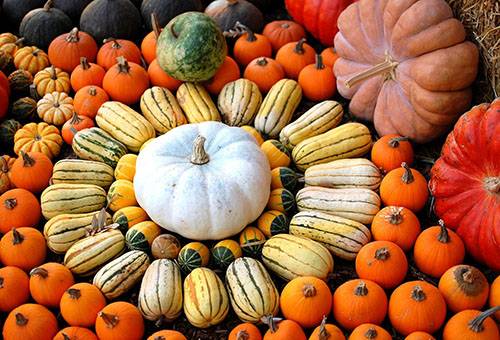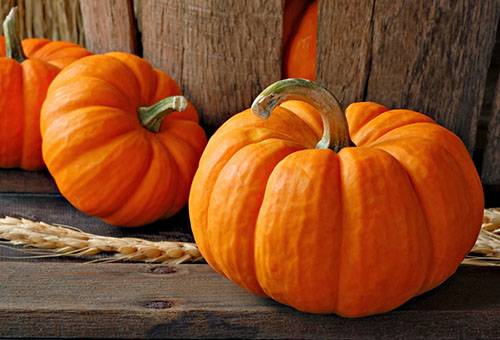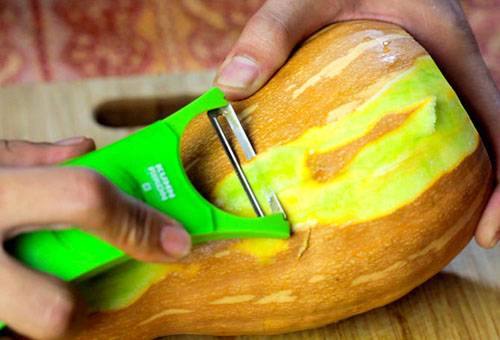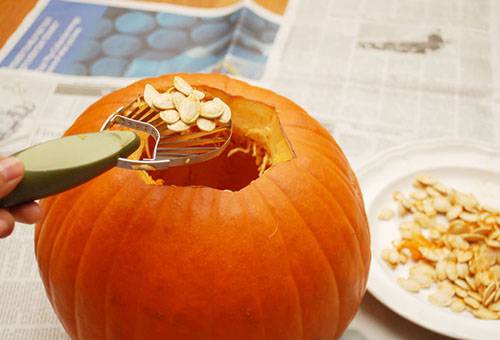How and how to peel a pumpkin?
Content:
With the participation of this unique vegetable, a lot of simple and delicious dishes are prepared. Due to its useful properties, nutritionists often prescribe it to people who have problems with the liver, digestive tract, kidneys, blood vessels, and eyesight. But so that the process of preparing, say, mashed pumpkin soup, porridge, casseroles or pancakes would bring pleasure, it is advisable to learn in time how to clean the pumpkin. Why is this so important? The fact is that the peel of the queen of vegetables is too hard. In order not to be injured, during the cleaning process you have to make great efforts and be careful. After all, out of ignorance you can get hurt from the very first movements.
Pumpkin varieties
So, so that there are fewer problems directly during this complex process that requires such efforts, you need to prepare for it in advance. After all, there are varieties of pumpkins that are easy to peel. Because now we will talk about them, about the varieties.
- Hardcore
It is easy to guess why they are so named - the peel of ripened fruits is too stiff. And it is clear that their cleaning is a very difficult and difficult work, which only a man can handle. But the variety is still good - it ripens early, has a small size and is famous for the most delicious seeds.
Shrub varieties are ideal.
- Large fruited
The origin of such a name is also clear. These are the largest specimens. They will have to tinker with during the preparation. After cleansing, the pumpkin can quickly disappear, because all the remnants are unlikely to enter the refrigerator. But there are pleasant moments here, because the fruits will delight in the fact that they are the sweetest (sometimes sweeter than watermelons), react better to others at lower temperatures and can be stored for a long time even in the apartment.
- Nutmeg
They like warmly, they keep up late, they may not mature where the summer is short, and therefore it is advisable to breed them in the south. But that seems to be all the cons. Because nutmeg varieties are the most delicious and vitamin ones, they are grown by seedlings (first seeds, and then plants into the ground), removed unripe until the first frosts (they “reach” the house).
Where to start peeling pumpkins?
So, each variety is good for something, and everyone chooses based on their preferences. But before proceeding with culinary research, the fetus must be cleaned. How to get started?
- Choose an instance suitable for a particular purpose.
- To clear of dirt, leaves and so on.
- Rinse thoroughly under the tap (especially when it comes to making juices, salads).
- Wipe with a towel or paper towel and allow to dry.
- To think over - whether it is necessary to cut everything, where to store the remains, etc.
How to remove the peel?
It all depends on some factors. Indeed, among the mass of varieties, each differs not only in color and state of the bark. There is also such a thing as shape, size and scope. After all, pumpkin pulp is often used on the farm. Therefore, it is important to get rid of the peel, and the stalk, and pericarp. Moreover, this process is individual for all varieties. Therefore, in preparation for work, both the structure of the product and which particular tools will be used are taken into account. If this happens in an ordinary kitchen, a knife and spoon are enough. Very helpful, especially with small sizes, the usual peeler.
Usually a vegetable is cut into necessary parts (often very small so as not to get hurt), and then carefully remove the hardened bark with a sharp knife. Why is this approach inconvenient? Not always all at once can be used, because there are fears that pieces of pumpkin may deteriorate without proper storage. Therefore, they often cost a surface treatment.
- To do this, the prepared product is placed on a cutting board, strengthening it so that it does not slip on the surface of the table.
- The ends are cut neatly on both sides with a large knife (somewhere at a distance of a couple of centimeters). They can be thrown out.
- With the help of a small vegetable knife with notches, peel the pumpkin by removing the small ribbons of the skin.
- You can, cut in half, put the halves down with a slice and cut into long lobes - so the knife does not slip on your fingers.
It is advisable to arrange the pumpkin comfortably, holding the knife vertically or horizontally. Then you need to proceed depending on what will be done in terms of the future fate of the fruit - whether they will be baked, or cooked, or laid in the freezer, and so on.
How to remove seeds?
Yes, this problem must be solved, because nothing can be prepared with seeds. They have a different fate. Therefore, they are carefully but carefully selected by hand or spoon along with the pulp. Having laid them on a plate, you can continue to work further with the fruits.
Tip
If you do not peel the whole pumpkin - both peel and seeds - then it can be sent to the refrigerator. But do not put in polyethylene - so it will quickly disappear. Such pieces can be stored for several days.
It is best to keep half of the pumpkin or peeled slices closer to the cold in some kind of vessel, covering it with cling film.
If there is no place in the refrigerator, and the plans do not have a pumpkin dish, you can peel it and cut into slices or grate. After packing everything in sachets, put it in the freezer.
Summer varieties are easier to clean, but they must be prepared immediately - they do not lie for a long time even in the refrigerator. But winter can be stored for a long time.
Pumpkin seeds are a useful product, because they can be dried and eaten.
Read an article about how to peel pumpkin seeds




Great cleaning advice if the peel is soft. And what if it is like plastic 2-3 mm thick? a knife for vegetables does not take it.